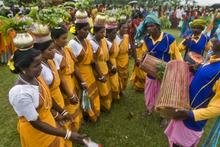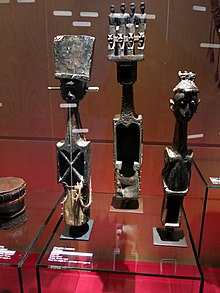 Santali people | |
| Total population | |
|---|---|
| 6,850,000–6,950,000 | |
| Regions with significant populations | |
| Jharkhand | 2,752,723[1] |
| West Bengal | 2,512,331[1] |
| Odisha | 894,764[1] |
| Assam | 800,000-900,000 |
| Bihar | 406,076[1] |
| 300,061 (2001)[2] | |
| 42,698[3] | |
| Languages | |
| Santali | |
| Religion | |
| Sari Dharam • Sarnaism • Hinduism • Christianity | |
| Related ethnic groups | |
| Mundas • Hos • Kols • other Mon-Khmer people | |

The Santal (Hindi: सांथाल, Bengali: সাঁওতাল, romanized: shãotāl, Nepali: सतार/सन्थाल, romanized: satār/santhāl ) are an Adivasi people indigenous to Terai of Nepal and India, who live mainly in Nepal and the Indian States of Jharkhand, West Bengal, Bihar, Odisha, Assam (part of the Tea Tribes). There is also a significant Santhal minority in neighboring Bangladesh, and a small population in Nepal. They are one of the largest tribal communities in India. The Santal mostly speak Santali.
Santali language
The Reverend J. Phillips published 'An Introduction to the Santal Language' in 1852, printed at the Calcutta School – Book Society's Press.
Lars Olsen Skrefsrud, a Norwegian missionary and a language researcher, published 'A Grammar of Santhali Language' in 1873.
Paul Olaf Bodding (born Gjøvik, Norway on 2 November 1865, died Odense, Denmark on 25 September 1938) was a Norwegian missionary, linguist and folklorist. He served in India for 44 years (1889–1933), and operated mainly from the town Dumka in the Santhal Parganas-district. Bodding created the first alphabet and wrote the first grammar for the Santhali-speaking native people in eastern India. In 1914 he also completed the translation of the Bible into the Santhali language.
In about 1925 Raghunath Murmu created Ol Chiki script for the Santali language.
Religions
One of the most studied tribal religions in India, the Santal religion (Sari Dharam) worships Marang buru (God), or Bonga (God) , as the Supreme Deity. The weight of belief, however, falls on a court of spirits (Bonga), who handle different aspects of the world and who are placated with prayers and offerings in order to ward off evil influences. These spirits operate at the village, household, ancestor, and sub-clan level, along with evil spirits that cause disease and can inhabit village boundaries, mountains, water, tigers, and the forest. A characteristic feature of the Santhal village is a sacred grove (known as the Jaher[4] or "Santal Sthal") on the edge of the settlement where many spirits live and where a series of annual festivals take place.[5]
A yearly round of rituals connected with the agricultural cycle, along with life-cycle rituals for birth, marriage and burial at death, involve petitions to the spirits and offerings that include the sacrifice of animals, usually birds. Religious leaders are male specialists in medical cures who practice divination and witchcraft (the socio-historic meaning of the term, used here, refers to the ritual practice of magic and is not pejorative). Similar beliefs are common among other tribes of northeast and central India such as the Kharia, Munda, and Oraon.[5]
Smaller and more isolated tribes often demonstrate articulated classification systems of the spiritual hierarchy less well documented, described as animism or a generalized worship of spiritual energies connected with locations, activities, and social groups. Religious concepts are intricately entwined with ideas about nature and interaction with local ecological systems. As in Santal religion, religious specialists are drawn from the village or family and serve a wide range of spiritual functions that focus on placating potentially dangerous spirits and coordinating rituals.[5]
Santali culture
Sohrai is the principal festival of Santal community. Besides that Baha, Karam, Dansai, etc. are important. Chadar Badar, a form of puppetry known also as Santal puppetry, is a folk show involving wooden puppets placed in a small cage which acts as the stage. The Santal traditionally accompany many of their dances with two drums: the Tamak‘ and the Tumdak’.[6]
Traditions of Santals
Sohrai is the biggest festival among Santals.
Notable people
- Sidhu Murmu and Kanhu Murmu, Freedom fighters against the British
- Tilka Manjhi
- Raghunath Murmu
- Sadhu Ramchand Murmu
- Sarada Prasad kisku (Totko Molong)
- Ramdas Tudu
- Birsa Munda
- Shibu Soren
- Babulal Marandi
- Draupadi Murmu Governor of Jharkhand, India
- Gobinda Chandra Majhi
- G. C. Murmu
- Jauna Murmu
- Arjun Tudu[7]
- Hemonto Soren
References
| This image is available from the United States Library of Congress Prints and Photographs Division under the digital ID (({id))} This tag does not indicate the copyright status of the attached work. A normal copyright tag is still required. See Wikipedia:Copyrights for more information. |
- ^ a b c d "A-11 Individual Scheduled Tribe Primary Census Abstract Data and its Appendix". www.censusindia.gov.in. Office of the Registrar General & Census Commissioner,India. Retrieved 18 November 2017.
- ^ Cavallaro, Francesco; Rahman, Tania. "The Santals of Bangladesh" (PDF). ntu.edu.sg. Nayang Technical University. Retrieved 17 November 2017.
((cite web)): Cite has empty unknown parameter:|dead-url=(help) - ^ "Santali: Also spoken in Nepal". Retrieved 1 April 2011.
- ^ "Jaher Worshiping Place of Santhals". Retrieved 27 September 2014.
- ^ a b c "The Green Revolution in India". U.S. Library of Congress Country Studies (released in public domain). Retrieved 6 October 2007.
- ^ "Chadar Badar". Telegraph. 2015. Retrieved 22 March 2015.
- ^ www.indiansuperleague.com. "Arjun Tudu - Forward, Delhi Dynamos FC | ISL Player Profile". www.indiansuperleague.com. Retrieved 31 January 2017.
Bibliography
- Archer, W. G. The Hill of Flutes: Life, Love, and Poetry in Tribal India: A Portrait of the Santals. Pittsburgh: University of Pittsburgh Press, 1974.
- Bodding, P. O. Santal Folk Tales. Cambridge, Mass.: H. Aschehoug; Harvard University Press, 1925.
- Bodding, P. O. Santal Riddles and Witchcraft among the Santals. Oslo: A. W. Brøggers, 1940.
- Bodding, P. O. A Santal Dictionary (5 volumes), 1933–36 Oslo: J. Dybwad, 1929.
- Bodding, P. O. Materials for a Santali Grammar I, Dumka 1922
- Bodding, P. O. Studies in Santal Medicine and Connected Folklore (3 volumes), 1925–40
- Bompas, Cecil Henry, and Bodding, P. O. Folklore of the Santal Parganas. London: D. Nutt, 1909. Full text at Project Gutenberg.
- Chakrabarti, Dr. Byomkes, A Comparative Study of Santali and Bengali, KP Bagchi, Calcutta, 1994
- Culshaw, W. J. Tribal Heritage; a Study of the Santals. London: Lutterworth Press, 1949.
- Edward Duyker Tribal Guerrillas: The Santals of West Bengal and the Naxalite Movement, Oxford University Press, New Delhi, 1987, pp. 201, SBN 19 561938 2.
- Hembrom. T, The Santals: Anthropological-Theological Reflections on Santali & Biblical Creation Traditions. 1st ed. Calcutta: Punthi Pustak, 1996.
- Orans, Martin. "The Santal; a Tribe in Search of a Great Tradition." Based on thesis, University of Chicago., Wayne State University Press, 1965.
- Prasad, Onkar. Santal Music: A Study in Pattern and Process of Cultural Persistence, Tribal Studies of India Series; T 115. New Delhi: Inter-India Publications, 1985.
- Roy Chaudhury, Indu. Folk Tales of the Santals. 1st ed. Folk Tales of India Series, 13. New Delhi: Sterling Publishers, 1973.
- Troisi, J. The Santals: A Classified and Annotated Bibliography. New Delhi: Manohar Book Service, 1976.
- ———. Tribal Religion: Religious Beliefs and Practices among the Santals. New Delhi: Manohar, 2000.
External links
- Saontal Voice in Bangladesh
- Santal Rebellion
- Santal Engineers' Welfare Association – Working for all round development of Adivasi
- All India Santal Welfare and Cultural Society
- Santal Arts
- Santal Dance
- Boro Baski: Santal worries
- Santal culture on Daricha Foundation website (Kolkata)
- Banam The bowed music instrument played by the Santals
- http://projekt.ht.lu.se/rwaai RWAAI (Repository and Workspace for Austroasiatic Intangible Heritage)
- http://hdl.handle.net/10050/00-0000-0000-0003-A6AF-2@view Santali language in RWAAI Digital Archive
| Indo-Aryans | |
|---|---|
| Austro-Asiatic | |
| Dravidian | |
| Tibeto-Burman | |
| Others | |
| Sino-Tibetan (Trans-Himalayan) |
| ||||||||
|---|---|---|---|---|---|---|---|---|---|
| Indo-Aryan |
| ||||||||
| Indo-Aryan of a distinct origin | |||||||||
| Other peoples (M, D, i) of Indus-Ganga |
| ||||||||
| Immigrants | |||||||||
| Other basis |
| ||||||||